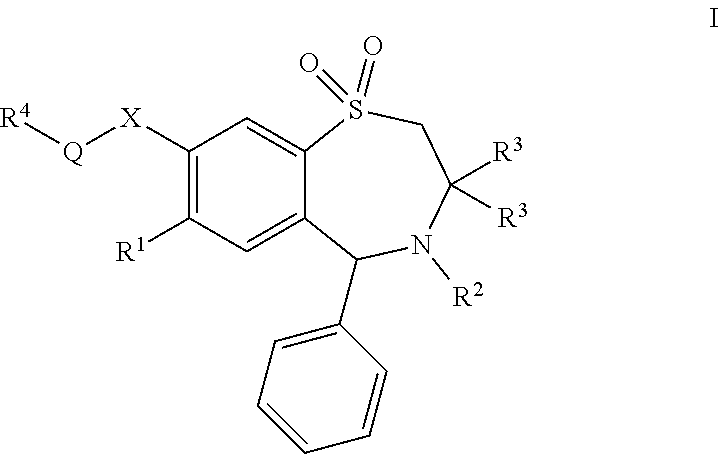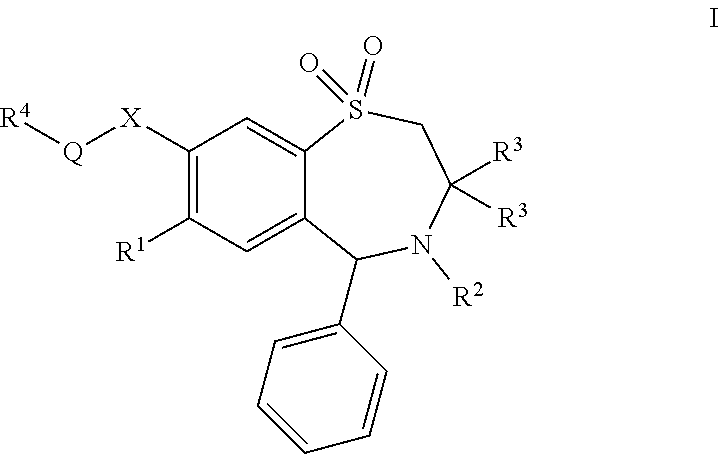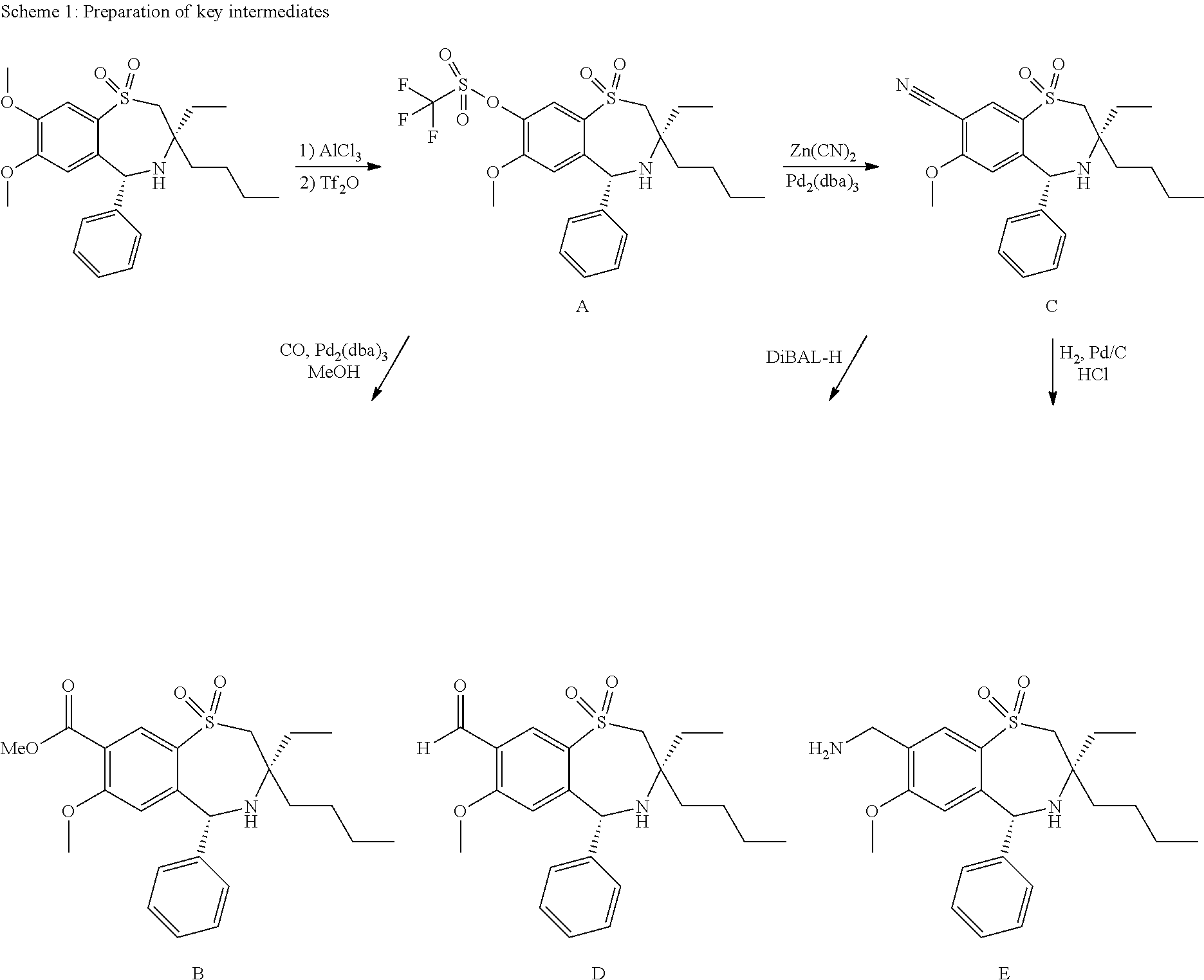Chemical Compounds
a technology of chemical compounds and compounds, applied in the field of chemical compounds, can solve the problems of other forms of cardiovascular disease), increased risk of macrovascular (heart disease, stroke, etc.) and microvascular
- Summary
- Abstract
- Description
- Claims
- Application Information
AI Technical Summary
Benefits of technology
Problems solved by technology
Method used
Image
Examples
example 1
3-({[(3R,5R)-3-butyl-3-ethyl-7-(methyloxy)-1,1-dioxido-5-phenyl-2,3,4,5-tetrahydro-1,4-benzothiazepin-8-yl]carbonyl}amino)-2,2-dimethylpropanoic acid
[0193]
[0194]Step 1: To a DMF (0.5 mL) solution of (3R,5R)-3-butyl-3-ethyl-7-(methyloxy)-5-phenyl-2,3,4,5-tetrahydro-1,4-benzothiazepine-8-carboxylic acid-1,1-dioxide (0.025 g, 0.058 mmol) and ethyl 3-amino-2,2-dimethylpropanoate (prepared as described in U.S. Pat. No. 2,370,015) (0.009 g, 0.064 mmol) at 0° C. was added HATU (0.024 g, 0.064 mmol) followed by DIEA (0.012 mL, 0.070 mmol). The reaction was stirred for 10 min then warmed to room temperature. After 1 h the reaction was concentrated to half volume, and H2O (3 mL) was added. The precipitant was filtered and dried then used without further purification in the next step.
[0195]Step 2: The material was dissolved in THF (0.500 mL), and H2O (0.250 mL) was added along with excess LiOH (7 mg, 0.174 mmol). The reaction was stirred at room temperature for 3 h then concentrated. The resid...
example 2
({[(3R,5R)-3-butyl-3-ethyl-7-(methyloxy)-1,1-dioxido-5-phenyl-2,3,4,5-tetrahydro-1,4-benzothiazepin-8-yl]carbonyl}amino)methanesulfonic acid
[0196]
[0197]Prepared in analogous fashion to Example 1 step 1 via HATU amide-coupling using aminomethanesulfonic acid (0.013 g, 0.116 mmol) and (3R,5R)-3-butyl-3-ethyl-7-(methyloxy)-5-phenyl-2,3,4,5-tetrahydro-1,4-benzothiazepine-8-carboxylic acid-1,1-dioxide (50 mg, 0.12 mmol) to give the title compound (45 mg, 73%): 1H NMR (400 MHz, CDCl3) δ ppm 8.47 (s, 1H) 8.28 (partially resolved t, J=5.72 Hz, 1 H) 7.47 (d, J=3.62 Hz, 5H) 6.29 (br. s., 1H) 6.02 (br. s., 1H) 3.43-4.72 (m, 6H+ H2O) 3.22 (br. s., 1H) 2.14 (br. s., 1H) 1.80 (br. s., 1H) 1.45 (br. s., 2H) 0.93-1.32 (m, 5H) 0.63-0.93 (m, 6H); ES-LCMS m / z 525 (M+H)+.
example 3
2-({[(3R,5R)-3-butyl-3-ethyl-7-(methyloxy)-1,1-dioxido-5-phenyl-2,3,4,5-tetrahydro-1,4-benzothiazepin-8-yl]carbonyl}amino)ethanesulfonic acid trifluoroacetate
[0198]
[0199]Prepared in an analogous fashion to Example 1 step 1 via HATU amide-coupling using taurine (0.014 g, 0.116 mmol) and (3R,5R)-3-butyl-3-ethyl-7-(methyloxy)-5-phenyl-2,3,4,5-tetrahydro-1,4-benzothiazepine-8-carboxylic acid-1,1-dioxide (0.050 g, 0.116 mmol). Purification via RP-HPLC (30×150 H2O Sunfire C18 Column) using MeCN / H2O 10-100% with 0.1% TFA as mobile phase over 8 min provided the title compound (0.015 g, 19%): 1H NMR (400 MHz, MeOH-d4) δ ppm 8.74 (s, 1H) 7.48-7.72 (m, 5H) 6.68 (s, 1H) 6.47 (s, 1H) 4.02 (d, J=15.83 Hz, 1H) 3.75-3.83 (m, 2H) 3.72 (s, 3H) 3.55 (d, J=15.83 Hz, 1H) 2.91-3.02 (m, 2H) 2.77 (br. s., 1H) 2.13 (br. s., 2H) 1.66 (s, 1H) 1.43 (d, J=6.55 Hz, 3H) 1.02 (partially resolved t, J=7.48 Hz, 4H) 0.91 (t, J=7.13 Hz, 3H); ES-LCMS m / z 539 (M+H)+.
PUM
| Property | Measurement | Unit |
|---|---|---|
| mass | aaaaa | aaaaa |
| temperature | aaaaa | aaaaa |
| volume | aaaaa | aaaaa |
Abstract
Description
Claims
Application Information
 Login to View More
Login to View More - R&D
- Intellectual Property
- Life Sciences
- Materials
- Tech Scout
- Unparalleled Data Quality
- Higher Quality Content
- 60% Fewer Hallucinations
Browse by: Latest US Patents, China's latest patents, Technical Efficacy Thesaurus, Application Domain, Technology Topic, Popular Technical Reports.
© 2025 PatSnap. All rights reserved.Legal|Privacy policy|Modern Slavery Act Transparency Statement|Sitemap|About US| Contact US: help@patsnap.com



